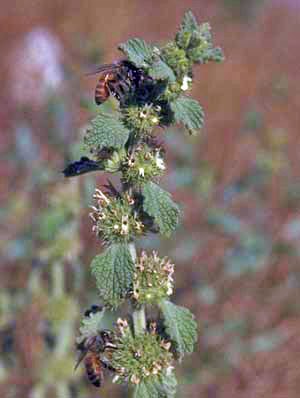|
Horehound (Marrubium vulgare) is a perennial weed from Europe. It is common in disturbed, low-elevation areas throughout California. There are several populations in the foothills of Sequoia National Park, with the greatest concentrations being in and near campgrounds. This species is a source of concern for park resource managers because it aggressively invades disturbed areas and it has the potential to invade neighboring undisturbed areas. Identification Horehound is a velvety gray-green perennial that rarely exceeds 5 decimeters (1.5 feet) in height. The leaves arise in pairs along the stems. They are round to oval, white-velvety, minutely toothed around the margins, and about 4 centimeters (1.6 inches) long. The flowers are small and pale and are born in regularly spaced clusters along the flowering stems. Seeds are tiny and are enclosed in small burrs that shamelessly colonize human socks in vast numbers. Look-Alikes Hedge nettle (Stachys albens) is a native mint that might be confused with horehound. Hedge nettle is much larger than horehound; mature hedge nettles are generally 5 to 25 decimeters (1.5-8 feet) tall. They are restricted to wet areas, they are very white-woolly, and their leaves are generally much larger than those of horehound. 
Photo by Brother Alfred Brousseau, St. Mary's College Natural History An individual horehound plant can produce thousands of seeds. These seeds, in their tiny burrs, can be dispersed to great distances by animals. Horehound colonies can become very dense in disturbed areas, and are resistant to trampling. This aromatic member of the mint family was once cultivated in great quantities for use in making candies and cough drops. Management Horehound has been treated in previous years by park maintenance personnel, who estimated having removed 60,000 plants from the foothill campgrounds of Sequoia National Park. The combined efforts of park maintenance personnel and weed crews should lead to ultimate eradication of this species from the parks. Plants will be removed by hand pulling or severing of roots well below ground level. An approved glyphosate herbicide may be used in a sparing and targeted manner where necessary. |
Last updated: March 1, 2015
